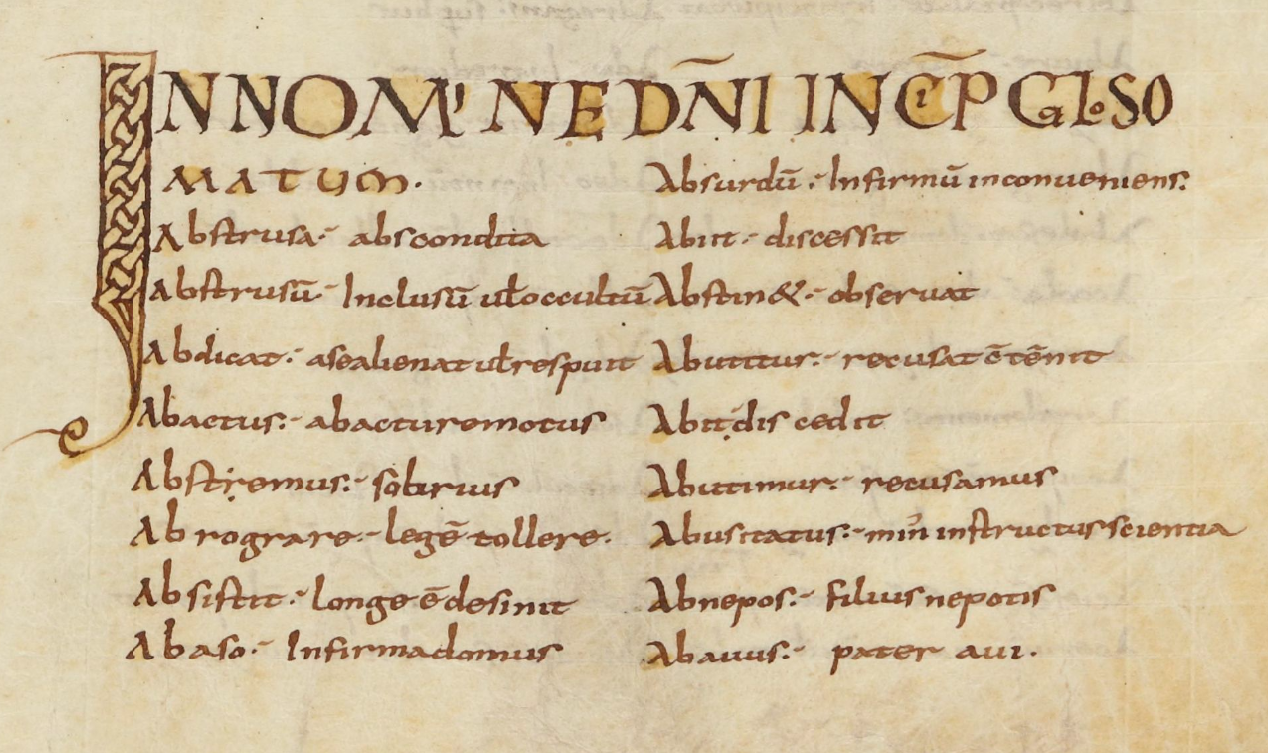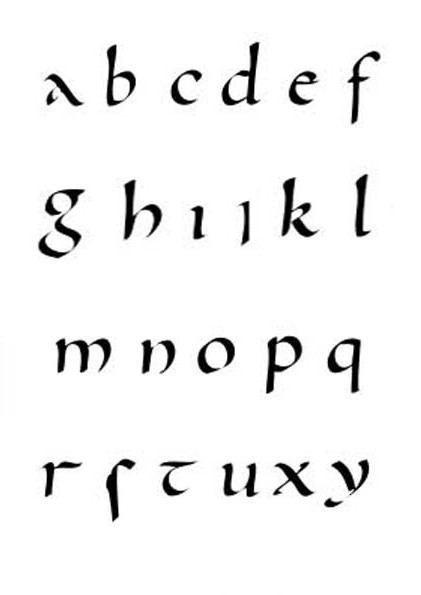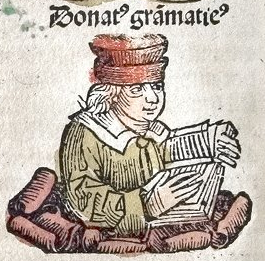|
Abstrusa Glossary
The ''Abstrusa Glossary'' is a glossary of Latin from the 7th or 8th century AD.. Typical of such glossaries, it is named after its first lemma, '' abstrusa''.. The ''Abstrusa'' was probably compiled in Gaul, possibly in Aquitaine, since the compiler provides Gaulish '' uerna'' as a vernacular translation of Latin ''alnus''. It is alphabetized to the third letter (i.e., ABC stage), indicating an organized, stable composition.. The ''Abstrusa'' can be found in five manuscripts and one fragment. In the oldest of these (Vatican lat. 3321), probably copied in central Italy in the 8th century, it is accompanied by the '' Abolita Glossary''. The same two glossaries are found together in a 10th-century manuscript from Monte Cassino (Cass. 439), which originated in Spain. Although they appear together, the two glossaries are distinct, making use of different sources and containing different definitions. The ''Abstrusa'' is transmitted separately in two manuscripts in the Bibliothèque Nat ... [...More Info...] [...Related Items...] OR: [Wikipedia] [Google] [Baidu] |
Caroline Minuscule
Carolingian minuscule or Caroline minuscule is a script which developed as a calligraphic standard in the medieval European period so that the Latin alphabet of Jerome's Vulgate Bible could be easily recognized by the literate class from one region to another. It is thought to have originated before AD 778 at the scriptorium of the Benedictine monks of Corbie Abbey, about north of Paris, and then developed by Alcuin of York for wide use in the Carolingian Renaissance. Alcuin himself still wrote in a script which was a precursor the Carolingian minuscule, which slowly developed over three centuries. He was most likely responsible for copying and preserving the manuscripts and upkeep of the script. It was used in the Holy Roman Empire between approximately 800 and 1200. Codices, pagan and Christian texts, and educational material were written in Carolingian minuscule. After blackletter developed out of it, the Carolingian minuscule became obsolete, until the 14th century Italian ... [...More Info...] [...Related Items...] OR: [Wikipedia] [Google] [Baidu] |
Ireland
Ireland ( ; ga, Éire ; Ulster Scots dialect, Ulster-Scots: ) is an island in the Atlantic Ocean, North Atlantic Ocean, in Northwestern Europe, north-western Europe. It is separated from Great Britain to its east by the North Channel (Great Britain and Ireland), North Channel, the Irish Sea, and St George's Channel. Ireland is the List of islands of the British Isles, second-largest island of the British Isles, the List of European islands by area, third-largest in Europe, and the List of islands by area, twentieth-largest on Earth. Geopolitically, Ireland is divided between the Republic of Ireland (officially Names of the Irish state, named Ireland), which covers five-sixths of the island, and Northern Ireland, which is part of the United Kingdom. As of 2022, the Irish population analysis, population of the entire island is just over 7 million, with 5.1 million living in the Republic of Ireland and 1.9 million in Northern Ireland, ranking it the List of European islan ... [...More Info...] [...Related Items...] OR: [Wikipedia] [Google] [Baidu] |
Proverbia Grecorum
The ''Proverbia Grecorum'' (sometimes ''Parabolae Gregorum'', both meaning "proverbs of the Greeks") is an anonymous Latin collection of proverbs compiled in the seventh or eighth century AD in the British Isles, probably in Ireland. Despite the name, it has no known Ancient Greek language, Greek source. It was perhaps designed as a secular complement to the Hebrew Bible's ''Book of Proverbs''. Within about a century of its composition, the ''Proverbia'' was being copied in northern Italy, yet all surviving manuscript have an Anglo-Saxon or Celtic nations, Celtic connection. Only one complete copy survives, but excerpts (with citations) are found in at least eight other manuscripts. There are seventy-four proverbs, but seven others with no connection to the original work are erroneously attributed to it in various manuscripts. Transmission Sedulius Scottus The original compilation consisted of 74 short proverbs and a prefatory letter. There is one surviving copy of the complete wo ... [...More Info...] [...Related Items...] OR: [Wikipedia] [Google] [Baidu] |
Sextus Pompeius Festus
Sextus Pompeius Festus, usually known simply as Festus, was a Roman grammarian who probably flourished in the later 2nd century AD, perhaps at Narbo ( Narbonne) in Gaul. Work He made a 20-volume epitome of Verrius Flaccus's voluminous and encyclopedic treatise '' De verborum significatione''. Flaccus had been a celebrated grammarian who flourished in the reign of Augustus. Festus gives the etymology as well as the meaning of many words, and his work throws considerable light on the language, mythology and antiquities of ancient Rome. He made a few alterations, and inserted some critical remarks of his own. He also omitted such ancient Latin words as had long been obsolete; these he apparently discussed in a separate work now lost, entitled ''Priscorum verborum cum exemplis''. Even incomplete, Festus' lexicon reflects at second hand the enormous intellectual effort that had been made in the Augustan Age to put together information on the traditions of the Roman world, which was alr ... [...More Info...] [...Related Items...] OR: [Wikipedia] [Google] [Baidu] |
Appendix Vergiliana
The ''Appendix Vergiliana'' is a collection of poems traditionally ascribed as being the juvenilia (work written as a juvenile) of Virgil.Régine ChambertVergil's Epicureanism in his early poems in "Vergil, Philodemus, and the Augustans" 2003: "Vergil's authorship of at least some of the poems in the Appendix is nowadays no longer contested. This is especially true of the Culex ... and also of a collection of short epigrams called the Catalepton." Many of the poems in the Appendix were considered works by Virgil in antiquity. However, recent studies suggest that the Appendix contains a diverse collection of minor poems by various authors from the 1st century AD. Scholars are almost unanimous in considering the works of the ''Appendix'' spurious, primarily on grounds of style, metrics, and vocabulary. Composition The collection most likely formed in Late Antiquity. The individual components are older: ancient authors considered the ''Culex'' to be a youthful work of Virgil's ... [...More Info...] [...Related Items...] OR: [Wikipedia] [Google] [Baidu] |
Maurus Servius Honoratus
Servius was a late fourth-century and early fifth-century grammarian. He earned a contemporary reputation as the most learned man of his generation in Italy; he authored a set of commentaries on the works of Virgil. These works, ''In tria Virgilii Opera Expositio'', constituted the first incunable to be printed at Florence, by Bernardo Cennini, in 1471. In the ''Saturnalia'' of Macrobius, Servius appears as one of the interlocutors; allusions in that work and a letter from Symmachus to Servius indicate that he was not a convert to Christianity. Commentary on Virgil The commentary on Virgil ( la, In Vergilii Aeneidem commentarii) survives in two distinct manuscript traditions. The first is a comparatively short commentary, attributed to Servius in the superscription in the manuscripts and by other internal evidence. The second class derive from the 10th and 11th centuries, embed the same text in a much expanded commentary. The copious additions are in contrasting style to ... [...More Info...] [...Related Items...] OR: [Wikipedia] [Google] [Baidu] |
Aelius Donatus
Aelius Donatus (; fl. mid-fourth century AD) was a Roman grammarian and teacher of rhetoric. Works He was the author of a number of professional works, of which several are extant: *Ars maior – A commentary on Latin grammar. * Ars minor – A commentary on parts of Latin Speech. * Commentvm Terenti, Publii Terentii Comoediae Sex with preface de tragoedia et comoedia (Commentary on Terence, Six Comedies of Terence with the preface About Tragedies and Comedies) – A commentary on the playwright Terence and all Six of his plays, probably compiled from other commentaries. The preface is a commentary on the "proper" structures of Tragedies and Comedies by Donatus titled, "About Comedies and Tragedies." It has never been translated to English as parts are missing from the original manuscript. It has partially been translated to German. * Explicatio in Ciceronis De inventione (An Explanation of the Cicero's De Inventione) * Vita Vergili (Life of Virgil) is thought to be based on a l ... [...More Info...] [...Related Items...] OR: [Wikipedia] [Google] [Baidu] |
Virgil
Publius Vergilius Maro (; traditional dates 15 October 7021 September 19 BC), usually called Virgil or Vergil ( ) in English, was an ancient Roman poet of the Augustan period. He composed three of the most famous poems in Latin literature: the '' Eclogues'' (or ''Bucolics''), the '' Georgics'', and the epic ''Aeneid''. A number of minor poems, collected in the '' Appendix Vergiliana'', were attributed to him in ancient times, but modern scholars consider his authorship of these poems as dubious. Virgil's work has had wide and deep influence on Western literature, most notably Dante's '' Divine Comedy'', in which Virgil appears as the author's guide through Hell and Purgatory. Virgil has been traditionally ranked as one of Rome's greatest poets. His ''Aeneid'' is also considered a national epic of ancient Rome, a title held since composition. Life and works Birth and biographical tradition Virgil's biographical tradition is thought to depend on a lost biography by the Rom ... [...More Info...] [...Related Items...] OR: [Wikipedia] [Google] [Baidu] |
Bible
The Bible (from Koine Greek , , 'the books') is a collection of religious texts or scriptures that are held to be sacred in Christianity, Judaism, Samaritanism, and many other religions. The Bible is an anthologya compilation of texts of a variety of forms originally written in Hebrew, Aramaic, and Koine Greek. These texts include instructions, stories, poetry, and prophecies, among other genres. The collection of materials that are accepted as part of the Bible by a particular religious tradition or community is called a biblical canon. Believers in the Bible generally consider it to be a product of divine inspiration, but the way they understand what that means and interpret the text can vary. The religious texts were compiled by different religious communities into various official collections. The earliest contained the first five books of the Bible. It is called the Torah in Hebrew and the Pentateuch (meaning ''five books'') in Greek; the second oldest part wa ... [...More Info...] [...Related Items...] OR: [Wikipedia] [Google] [Baidu] |
Scholia
Scholia (singular scholium or scholion, from grc, σχόλιον, "comment, interpretation") are grammatical, critical, or explanatory comments – original or copied from prior commentaries – which are inserted in the margin of the manuscript of ancient authors, as glosses. One who writes scholia is a scholiast. The earliest attested use of the word dates to the 1st century BC. History Ancient scholia are important sources of information about many aspects of the ancient world, especially ancient literary history. The earliest scholia, usually anonymous, date to the 5th or 4th century BC (such as the ''scholia minora'' to the ''Iliad''). The practice of compiling scholia continued to late Byzantine times, outstanding examples being Archbishop Eustathius' massive commentaries to Homer in the 12th century and the ''scholia recentiora'' of Thomas Magister, Demetrius Triclinius and Manuel Moschopoulos in the 14th. Scholia were altered by successive copyist ... [...More Info...] [...Related Items...] OR: [Wikipedia] [Google] [Baidu] |
Second Amplonian Glossary
The second (symbol: s) is the unit of time in the International System of Units (SI), historically defined as of a day – this factor derived from the division of the day first into 24 hours, then to 60 minutes and finally to 60 seconds each (24 × 60 × 60 = 86400). The current and formal definition in the International System of Units ( SI) is more precise:The second ..is defined by taking the fixed numerical value of the caesium frequency, Δ''ν''Cs, the unperturbed ground-state hyperfine transition frequency of the caesium 133 atom, to be when expressed in the unit Hz, which is equal to s−1. This current definition was adopted in 1967 when it became feasible to define the second based on fundamental properties of nature with caesium clocks. Because the speed of Earth's rotation varies and is slowing ever so slightly, a leap second is added at irregular intervals to civil time to keep clocks in sync with Earth's rotation. Uses Analog clocks and watches often ... [...More Info...] [...Related Items...] OR: [Wikipedia] [Google] [Baidu] |







.jpg)
